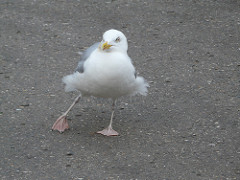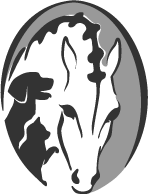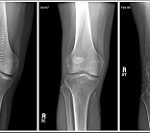All Limps Are Not Made Equal
 A limp can have more meaning than one might fathom. Ranging from a simple muscle spasm to cancer, a limp is something that should not be taken lightly. At one point or another, most animals and humans will deal with a change in gait in the form of a limp. While some come and go, others may be more frequent and consistent. Not all limps are made equal, and all should be questioned if not evaluated in timely fashion.
A limp can have more meaning than one might fathom. Ranging from a simple muscle spasm to cancer, a limp is something that should not be taken lightly. At one point or another, most animals and humans will deal with a change in gait in the form of a limp. While some come and go, others may be more frequent and consistent. Not all limps are made equal, and all should be questioned if not evaluated in timely fashion.
A limp could indicate a muscle strain, sprained ligament, pinched nerve, torn tendon, jammed toe, foreign object presence, dislocation, dysplasia, arthritis, disc disease, or even cancer. With such a wide range of conditions potentially leading to a limp, it stands to reason finding out the WHAT behind the gait change is important.
A change in gait is first and foremost an indicator that something else is going on within your pet. Whether the limp resolves itself, and how quickly it resolves are important things to note. How often it happens (in any given time period), when it happens (whether after strenuous activity or being sedentary for long periods of time), and if there is pain associated with the action are all need to know questions.

A chronic limp, one that occurs fairly constantly throughout the day and does not seem to improve regardless of activity, is often indicative of a structural shift within the body. When there is abnormal structure in the spine, an animal’s body will alter itself to compensate for that abnormality. As they continue to age and more daily “traumas” occur, this compensation will weaken. With each new injury there tends to be another compensation. At a point, the body becomes to fragile that even the slightest of motions or activities will lead to a complete bodily breakdown, starting with compensations first. When this happens, a limp that at one time would come and go can become almost constant, and occasionally painful. When the structural shift is addressed and corrected, the body no longer needs to maintain various compensations and can instead return to a state of normalcy. The stress places on muscles, ligaments, and nerves from the shifts are relieved and the symptoms, such as limping, often resolve quickly.
A chronic limp that is very painful and does not show any sort of resolution, sometimes accompanied by constant heat and swelling, can indicate the presence of cancer. As with any disease process, I highly recommend having your animal evaluated by your veterinarian when it comes to a chronic painful limp. Though a structural shift may be present in conjunction, if chiropractic adjustments do not seem to help the condition, it is most likely that something more is going on internally.
 An acute limp that comes and goes, lasting for anywhere from five minutes to a couple of hours or days, is not one that should be ignored. If your pet consistently experiences minor limping, it is most likely indicative of a structural shift in it’s earlier stages. Rather than ignore the problem when it resolves suddenly, it is important to address the limp sooner than later. No animal will limp without a reason behind the action. They do not crave attention or show weakness unless they have reason to do so. A limp is an example of your pet saying “something isn’t quite right, and I’m going to do whatever I can to make this go away, but there is something wrong that needs attention, please!”. Because they are not complainers, animals will truly hide injuries and let them fester until the last possible moment. Do not allow something minor turn into something major. Just because a limp goes away for a while, does not mean the cause of the limp is not there, it simply implies there is now a hidden problem.
An acute limp that comes and goes, lasting for anywhere from five minutes to a couple of hours or days, is not one that should be ignored. If your pet consistently experiences minor limping, it is most likely indicative of a structural shift in it’s earlier stages. Rather than ignore the problem when it resolves suddenly, it is important to address the limp sooner than later. No animal will limp without a reason behind the action. They do not crave attention or show weakness unless they have reason to do so. A limp is an example of your pet saying “something isn’t quite right, and I’m going to do whatever I can to make this go away, but there is something wrong that needs attention, please!”. Because they are not complainers, animals will truly hide injuries and let them fester until the last possible moment. Do not allow something minor turn into something major. Just because a limp goes away for a while, does not mean the cause of the limp is not there, it simply implies there is now a hidden problem.
An acute limp that happens after being in a down state for an extended period tends to be associated with arthritis, and is usually seen in older animals. Occasionally in younger pets if they struggle after being down it can be because of a mild muscle spasm or nothing more than a stiff joint.
A limp that occurs after strenuous activities or after a slight trauma could easily be associated with a torn or sprained ligament. These tend to be more structurally related and take some time to heal, as inflammation and swelling is usually present alongside the gait change. Situations like this resolve in time, though it does take a very aware owner to help in the healing process.
 With any change in gait, the first course of action is a palpatory exam. Upon palpation, it is important to note any temperature changes, tender spots, and muscle spasms. After static palpation, a motion palpation exam will be performed. Any limitations in range of motion in a joint should be noted, any crepitus within a joint, or any soreness upon movement. If necessary, radiographs will be advised to help identify any bony problems, such as dysplasia or arthritis.
With any change in gait, the first course of action is a palpatory exam. Upon palpation, it is important to note any temperature changes, tender spots, and muscle spasms. After static palpation, a motion palpation exam will be performed. Any limitations in range of motion in a joint should be noted, any crepitus within a joint, or any soreness upon movement. If necessary, radiographs will be advised to help identify any bony problems, such as dysplasia or arthritis.
What if the radiographs appear negative, but the other examinations were not? The likelihood that your pet has a structural shift occurring is fairly high. Often times, when your veterinarian is unable to give a definitive diagnosis off of an x-ray, the answer involves structural shifting of the spine. A structural shift is not seen on x-ray because it involves motion in a joint. It is detected through a combination of examinations, not one thing alone. When a structural shift is present, it can lead to limping, arthritis, muscle spasms, etc as stated above. The best thing any owner can do when it comes to limping is to have it evaluated sooner than later, it’s much easier to address a limp at the beginning rather than wait until it does not end.
Photo Credit:
A Hedgehog’s Back via photopin (license)
Seagull with Herr Flick walk via photopin (license)
Just walk this way. via photopin (license)
Friend In Need via photopin (license)
Hard at Play via photopin (license)
Dave the dog gets success via photopin (license)



Leave a Reply
Want to join the discussion?Feel free to contribute!